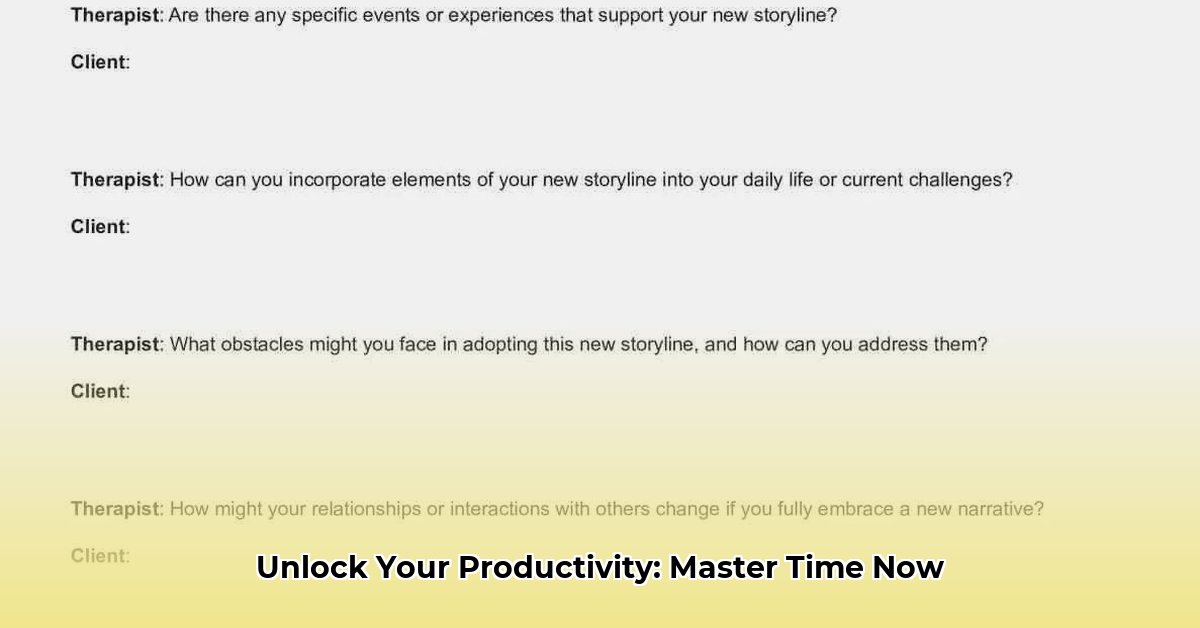Ever feel like you’re constantly chasing your tail, with seemingly not enough time in the day? You’re not alone! This guide offers practical tips and actionable activities to help you take control of your time. We’ll explore how to prioritize tasks, overcome procrastination, and boost productivity. For more on setting time management goals, check out this helpful resource: Time Management Goals. Get ready to become a time management master!
Time Management Activities: Supercharge Your Productivity
Feeling overwhelmed? Millions struggle with effective time management. Mastering simple techniques can dramatically improve your productivity and reduce stress. This guide offers a curated list of activities – some solo, some teamwork-based – to help you become a time management guru, optimizing focus and minimizing distractions. Master effective focus and productivity to achieve your goals.
Prioritizing Your Time: Making the Most of Every Minute
These activities help focus on what matters, ditching the fluff and concentrating on high-impact tasks. Structure your day for success, minimizing wasted time and maximizing your potential.
-
The Eisenhower Matrix (Urgent/Important): A simple grid categorizes tasks by “urgency” (needs immediate attention?) and “importance” (contributes to long-term goals?). Classify your tasks:
- Important & Urgent: Tackle these tasks FIRST (e.g., crisis management, critical deadlines).
- Important, Not Urgent: Schedule these for focused work (e.g., strategic planning, relationship building, preventative maintenance).
- Urgent, Not Important: Delegate these if feasible (e.g., some meetings, routine requests, minor interruptions).
- Neither Urgent Nor Important: Eliminate these to free up precious time (e.g., time-wasting activities, excessive social media browsing).
This clarifies priorities and prevents you from getting bogged down in less critical activities. Refine your decision-making and focus on impactful areas.
-
The 80/20 Rule (Pareto Principle): This principle posits that 80% of your results stem from 20% of your efforts. Pinpoint that crucial 20% – the tasks with the biggest payoff – and concentrate your energy there. Maximize impact by prioritizing productive activities. For example, a writer could focus on actual writing instead of endlessly perfecting the outline. Embrace efficiency and effectiveness by concentrating on what yields the most substantial outcomes.
-
Time Audit: Where Does Your Time Really Go?: Meticulously track everything you do, and how long it takes, for an entire week. Be honest, detailed and precise! You might be shocked at where your time actually goes. This increased self-awareness marks the first step toward improvement. Identify time-sucking activities to reduce or eliminate. Use this diagnostic approach to refine habits and create a more focused agenda. Analyze your schedule, categorize your work, and make a time blocking system to prevent the problem from reoccurring.
-
Eat the Frog: This involves tackling your most challenging and least desirable task first thing in the morning. By conquering your “frog” early, you gain momentum and a sense of accomplishment, setting a positive tone for the rest of the day. Overcome resistance and psychological barriers by confronting the task you dread most.
Taming the Procrastination Beast: Getting Things Done
Procrastination serves as the enemy of productivity. These activities help you conquer distractions and refine your workflow.
-
The Pomodoro Technique: Focused Work Intervals: Work in concentrated, 25-minute intervals (a “Pomodoro”), followed by a 5-minute break. After four Pomodoros, take a longer, more restorative break (15-30 minutes). This makes tasks seem less overwhelming, especially large projects. Short breaks boost focus and prevent burnout. Embrace structure using this classic productivity timer.
-
The Two-Minute Rule: Immediate Action on Small Tasks: If a task can be completed in under two minutes, do it immediately. Don’t allow small tasks to accumulate and become a daunting mountain later. This simple technique prevents minor tasks from snowballing into significant burdens.
-
Task Decomposition: Divide and Conquer: Overwhelmed by a large project? Break it down into smaller, more manageable steps. This makes the overall goal less intimidating and provides a sense of visible progress, keeping you motivated. Employ chunking to dismantle perceived complexity, paving the way for steady progress.
-
Pre-Commitment: This involves making a public declaration or agreement to complete a task by a specific deadline. The added accountability can serve as a powerful motivator to overcome procrastination. Announce your intentions to build external pressure, pushing yourself towards compliance.
Sharpening Your Time Sense: Cultivating Awareness
These activities refine your perception of time, leading to improved estimations and planning. Enhance your ability to effectively gauge task duration and prevent over or under-scheduling.
-
The “How Long is a Minute?” Challenge: Close your eyes and try to estimate when one minute has passed. Repeat this several times. This surprisingly enhances your sense of time duration. Improve your ability to internally monitor pace and prevent tasks from dragging on.
-
Time Estimation Games: Engage in games that involve estimating time. This makes improving your accuracy in gauging how long tasks will take more fun. Gamify your approach to refining time perception skills, increasing the probability of precise planning.
-
Mindfulness and Meditation: Focusing Your Energy: Practicing mindfulness, even for a few minutes daily, significantly improves focus and reduces distractions, indirectly impacting your time management abilities. It’s about being present, aware, and concentrated. Incorporating mindfulness cultivates heightened awareness, indirectly translating into superior task management.
Teamwork Triumphs: Optimizing Team Time
These activities harness the power of collaboration to enhance team productivity and ensure seamless communication.
-
Team Time Audit: As a team, analyze how time is spent on projects. Pinpoint bottlenecks and inefficiencies. This collaborative approach enables problem-solving and fosters effective solutions. Identify process gaps and promote efficient workflows by jointly analyzing how your team invests its time.
-
Jigsaw Puzzle Analogy: Use a jigsaw puzzle to represent a project. Team members work together, learning how to coordinate tasks effectively and delegate efficiently. This illustrates the importance of collaboration in completing complex projects. Illuminating process interdependencies and cultivating group problem-solving abilities is essential.
-
Role-Playing Scenarios: Develop scenarios that simulate real-world project management challenges with time constraints. Teams practice time management and decision-making under pressure. Use gamified scenarios to simulate realistic business dilemmas, stress-testing decision-making skills in controlled settings.
-
Daily Stand-Up Meetings: Implement short, focused daily meetings where each team member shares what they worked on yesterday, what they plan to work on today, and any roadblocks they anticipate. These quick check-ins ensure everyone is aligned and aware of potential time-related challenges.
Facilitating Time Management Activities: Tips for Success
To make these activities meaningful, remember these key points: These insights ensure increased engagement and long-term advantages.
- Crystal Clear Instructions: Provide simple, straightforward instructions that are easily understood.
- Make it Engaging: Employ interactive games, discussions, and visual aids to keep things interesting and relevant.
- Reflect and Share: Allocate time for debriefing; discuss what worked, what didn’t, and what everyone learned.
- Tailor to Your Crowd: Adapt activities to the specific needs and learning styles of your group.
Remember, consistency is key. Select one or two activities that resonate with you, and integrate them into your routine. You’ll be surprised by the positive impact on your productivity and overall well-being. Which activity will you embrace first?
Measuring the Effectiveness of Different Time Management Training Activities
Want to determine if your time management training is truly effective? Completing a course isn’t enough; you need demonstrable data. Let’s explore effective methods for measuring the impact of your training and determine if the insights offered are translating into tangible time-management capabilities.
Assessing Time Management Training: A Multi-Faceted Approach
Measuring the success of time management training isn’t a one-size-fits-all endeavor. Implement a multi-faceted approach, incorporating both how participants feel about the training and how their behavior changes afterward. This ensures a comprehensive view, encompassing subjective opinions and quantifiable performance metrics.
Quantitative Measures: These measures give you hard numbers for evaluating the usefulness and effectiveness of your plan.
-
Pre- and Post-Training Assessments: Use quizzes or tests to assess knowledge and skills before, during and after training. Measure knowledge gain and skill improvement. Implement pre, mid and post training evaluations using quantitative tools to measure concrete changes in comprehension.
-
Time Tracking Analysis: Ask participants to monitor their time usage before and after training. Analyze time spent on essential functions and activities. This provides concrete evidence of behavioral changes.
-
Productivity Metrics: Measure key performance indicators (KPIs) relevant to the workplace. These may include project completion times, meeting efficiency, or number of tasks completed. The change in these metrics will be a key indicator of training success.
-
Error Rate: Track the number of errors made before and after the training. Improved time management often leads to reduced errors.
Qualitative Measures: These provide valuable insight into the training experience and its long-term impact.
-
Surveys and Feedback Forms: Gather participant feedback on their experience, the usefulness of the training, and their perceived improvement. Identify areas for growth in upcoming sessions.
-
Observations: Observe participants in their work
- Corporate Wellness Programs Cost Factors Impacting Your Company Budget - December 18, 2025
- Unpacking the Cost of Wellness Programs and Their Real Value - December 17, 2025
- How Much Do Wellness Programs Cost Businesses To Offer? - December 16, 2025
















